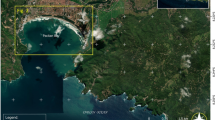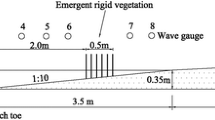Abstract
Damage to vegetation by tsunami moment and reduction of potential tsunami force are discussed based on a numerical simulation. A numerical model based on two-dimensional nonlinear long-wave equations that include drag forces and turbulence-induced shear force due to the presence of vegetation was developed to estimate tree breaking. The numerical model was then applied to a coastal forest where two dominant tropical vegetation species, Pandanus odoratissimus and Casuarina equisetifolia, were considered. The threshold water depth for tree breaking increased with increasing forest width, and the analysis was consistent with the field investigation results that the critical tsunami water depth for breaking is around 80% of the tree height for P. odoratissimus. C. equisetifolia is stronger than P. odoratissimus against tsunami action, but P. odoratissimus can reduce a greater tsunami force than C. equisetifolia due to its complex of aerial root structures. Even if breakage occurs, P. odoratissimus still has high potential to reduce the tsunami force due to its dense aerial root structures. Previous numerical models that do not include the breaking phenomena may overestimate the vegetation effect for reducing tsunami force. The combination of P. odoratissimus and C. equisetifolia is recommended as a vegetation bioshield to protect coastal areas from tsunami hazards.

















Similar content being viewed by others
References
Danielsen F, Sorensen MK, Olwig MF, Selvam V, Parish F, Burgess ND, Hiraishi T, Karunagaran VM, Rasmussen MS, Hansen LB, Quarto A, Suryadiputra N (2005) The Asian tsunami: a protective role for coastal vegetation. Science 310:643
Fritz et al (2007) Extreme runup from the 17 July 2006 Java tsunami. Geophys Res Lett 34:L12602. doi:10.1029/2007GL029404
Harada K, Imamura F (2005) Effects of coastal forest on tsunami hazard mitigation—a preliminary investigation, tsunamis: case studies and recent development. In: Satake K (ed) Advances in Natural and Technological Hazards Research. Springer, pp 279–292
Imamura F, Shuto N, Goto C (1998) Numerical simulation of the transoceanic propagation of tsunami. Proceedings of paper presented at the Sixth Congress of the Asian and Pacific Regional Division, Int. Assoc. Hydraul. Res., Kyoto, Japan
Kathiresan K, Rajendran N (2005) Coastal mangrove forests mitigated tsunami. Estuar Coast Shelf Sci 65:601–606
Kawata Y, Borrero J, Davies H, Imamura F, Letz H, Nott J, Synolakis C (1999) Tsunami in Papua New Guinea was as intense as first thought, EOS, Transactions AGU, 80(9):101 and 104–105
Kerr AM, Baird HB (2007) Natural barriers to natural disasters. Bioscience 57(2):102–103
Lynett PJ, Borer J, Liu PLF, Synolasis CE (2003) Field survey and Numerical modeling of the 1998 Papua New Guinea tsunami. Pure App Geophys 160(3):2119–2146. doi:10.1007/s00024-003-2422-0
Liu PL, Cho YS, Yoon SB, Seo SN (1994) Numerical simulations of the 1960 Chilean tsunami propagation and inundation at Hilo, Hawaii. In: El-Sabh MI (ed) Recent development in tsunami research. Kluwer Academic Publishers pp 99–115
Mascarenhas A, Jayakumar S (2008) An environmental perspective of the post-tsunami scenario along the coast of Tamil Nadu, India: role of sand dunes and forests. J Environ Manage 89:24–34
Nadaoka K, Yagi H (1998) Shallow-water turbulence modeling and horizontal larger eddy computation of river flow. J Hydraul Eng 124(5):493–500
Nandasena NAK, Tanaka N, Tanimoto K (2008) Tsunami current inundation of ground with coastal vegetation effects: an initial step towards a natural solution for tsunami amelioration. J Earthq Tsunami 2:157–171
Okal et al (2010) Field survey of the Samoa tsunami of 29 September 2010. Seismol Res Lett 81(4):577–591. doi:10.1785/gssrl.81.4.577
Poulin S, Larsen A (2007) Drag loading of circular cylinders inclined in the along-wind direction. J Wind Eng 95:1350–1363
Synolakis CE, Bardet JP, Borrero JC, Davies HL, Okal EA, Silver EA, Sweet S, Tappin DR (2002) Slump origin of the 1998 Papua New Guinea Tsunami. Field survey and Numerical modeling of the 1998 Papua New Guinea tsunami. Pure App Geophys 160(3):2119–2146. doi:10.1007/s00024-003-2422-0
Shuto N (1987) The effectiveness and limit of tsunami control forests. Coast Eng Jpn 30(1):143–153
Tanaka N (2009) Vegetation bioshields for tsunami mitigation: review of the effectiveness, limitations, construction, and sustainable management. Landsc Ecol Eng 5:71–79
Tanaka N, Sasaki Y (2007) Limitations of coastal vegetation in the 2004 Indian Ocean tsunami and 2006 Java tsunami, IAHR 32nd Congress, Venice, Italy
Tanaka N, Sasaki Y, Mowjood MIM, Jinadasa KBSN (2007) Coastal vegetation structures and their functions in tsunami protection: experience of the recent Indian Ocean tsunami. Landsc Ecol Eng 3:33–45
Tanaka N, Nandasena NAK, Jinadasa KBSN, Sasaki Y, Tanimoto K, Mowjood MIM (2009) Developing effective vegetation bioshield for tsunami protection. J Civ Environ Eng Syst 26:163–180
Thuy NB, Tanimoto K, Tanaka N, Harada K, Iimura K (2009a) Effect of open gap in coastal forest on tsunami run-up—Investigations by experiment and numerical simulation. Ocean Eng 36:1258–1269
Thuy NB, Tanaka N, Tanimoto K, Harada K, Iimura, K (2009b) Tsunami flow behind the coastal forest with an open gap-effects of tsunami and tree condition. Proceedings of the 6th International Conference on Coastal Dynamic, Tokyo-Japan (CD-Rom). doi:10.1142/9789814282475_0050
Thuy NB, Tanimoto K, Tanaka N (2010) Flow and potential force due to runup tsunami around a coastal forest with a gap—experiments and numerical simulations. Int J Sci Tsunami Hazards 29:43–69
Titov VV, Synolakis CE (1997) Extreme inundation flows during the Hokkaido Nansei-Oki tsunami. Geophys Res Lett 24(11):1315–1318
Tsuji Y, Imamura F, Matsutomi H, Synolakis CE, Nanang PT, Jumadi HS, Han SS, Arai K, Cook B (2003) Field survey of the East Java earthquake and tsunami. PAGEOPH 144(3/4):839–854
Yanagisawa H, Koshimura S, Goto K, Miyagi T, Imamura F, Ruangrassamee A, Tanavud C (2009) The reduction effects of mangrove forest on a tsunami based on field surveys at Pakarang Cape, Thailand, and numerical analysis. Estuar Coast Shelf Sci 81:27–37
Acknowledgements
This work was supported in part by JSPS AA Science Platform Program. Mr. N.A.K. Nandasena is acknowledged for his help. The first author would like to acknowledge the financial support by National Foundation for Science & Technology Development (NAFOSTED) of Vietnam.
Author information
Authors and Affiliations
Corresponding author
Rights and permissions
About this article
Cite this article
Thuy, N.B., Tanaka, N. & Tanimoto, K. Tsunami mitigation by coastal vegetation considering the effect of tree breaking. J Coast Conserv 16, 111–121 (2012). https://doi.org/10.1007/s11852-011-0179-7
Received:
Revised:
Accepted:
Published:
Issue Date:
DOI: https://doi.org/10.1007/s11852-011-0179-7




